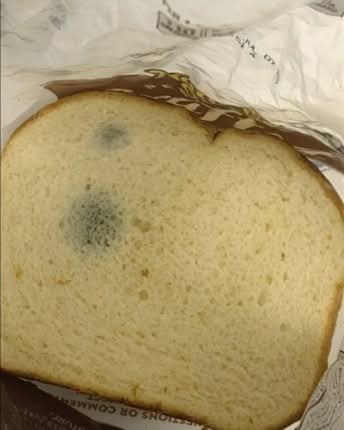🍞 Don’t Cut It Off: The Truth About Moldy Bread
We’ve all been there: You reach into the bread bag for a quick sandwich, then you see it — a fuzzy blue-green spot on one corner of the loaf. “It’s just one small patch,” you think. “If I cut it off, the rest should be fine… right?”
Wrong.
Unlike hard cheeses or salami, mold on bread means the entire loaf is likely contaminated — even if only one part looks affected.
Let’s explore what mold really is, why you should never eat moldy bread, and how to store your loaves safely — so you can protect your health and reduce food waste wisely.
Because real food safety isn’t about panic. It’s about knowing when to save — and when to throw away.
🔍 What Is Mold?
Mold is a type of fungus that grows in multicellular filaments called hyphae. These thread-like structures spread through porous materials — including bread — often far beyond what’s visible to the naked eye.
| Appearance | Common Species/Stage | Note |
|---|---|---|
| ✅ Blue-green | Penicillium species | (Same family as penicillin — but not safe to eat) |
| ✅ White (fuzzy film) | Early-stage mold | Often mistaken for flour dust |
| ✅ Black or gray | Aspergillus, Rhizopus | Some can produce harmful mycotoxins |
📌 Mold thrives in warm, moist environments — making your kitchen counter a perfect breeding ground.
❌ Why You Should Never Eat Moldy Bread
Even if the mold seems minor, cutting it off doesn’t make it safe:
-
Invisible Roots Spread Through the Loaf
The fluffy spot you see is just the “fruit” of the mold. Underneath, invisible threads (hyphae) have already spread throughout the crumb. In soft foods like bread, you can’t “cut around” the mold safely. 🚫 It’s like trying to remove tree roots by plucking a single leaf.
-
Hidden Mycotoxins May Be Present
Some molds produce mycotoxins — toxic substances that can survive heat and aren’t destroyed by toasting. While occasional exposure is unlikely to cause harm, repeated intake may affect liver, immune system, or long-term health — especially in children, elderly, or immunocompromised individuals.
-
Allergic Reactions & Respiratory Issues
Breathing in mold spores can trigger: Sneezing, runny nose, Asthma attacks, Allergic reactions. ⚠️ Never sniff moldy bread to “check” it — you risk inhaling spores.
✅ When Is It Safe to Eat Around Mold?
Only in certain hard, low-moisture foods, where mold can’t penetrate deeply:
| Food | Safe to Cut? | Reason/Action |
|---|---|---|
| ✅ Hard cheese (Cheddar, Parmesan) | Yes | Dense texture limits mold spread — cut 1 inch around and below |
| ✅ Salami | Yes | Surface mold is sometimes intentional; wipe with vinegar |
| ✅ Carrots, cabbage, bell peppers | Yes | Firm structure prevents deep penetration |
| ❌ Bread, cake, soft fruit, yogurt, lunch meat | No | Porous or moist — mold spreads invisibly |
📌 Rule of thumb: When in doubt, throw it out.
✅ How to Keep Your Bread Fresher Longer
Prevention beats disposal.
- ✅ Store in a cool, dry place: Slows mold growth.
- ✅ Use a bread box or cloth bag (for short-term): Allows airflow while reducing moisture buildup.
- ✅ Freeze extra slices: Stays fresh for up to 3 months — toast straight from frozen.
- ✅ Avoid plastic bags at room temperature: Traps moisture → speeds up spoilage.
- ✅ Buy smaller loaves if you don’t eat fast: Reduces waste.
🍞 Pro Tip: Sourdough lasts slightly longer due to natural acidity — but still goes bad eventually.
❓ Can Toasting Kill Mold?
No.
Toasting kills surface bacteria and makes stale bread edible — but it does NOT destroy mold or mycotoxins. A piece of bread with visible mold remains unsafe, even after high heat. 🚫 Don’t try to “rescue” it with the toaster.
❌ Debunking the Myths
- ❌ “If I can’t see mold, it’s safe”: Not true — early mold is colorless; smell or taste changes are red flags.
- ❌ “One bite won’t hurt”: Possibly not — but why risk nausea, allergic reaction, or toxin exposure?
- ❌ “Store-bought preservatives make bread last forever”: False — preservatives delay mold, but don’t stop it indefinitely.
- ❌ “Dry bread can’t grow mold”: Dangerous myth — dried bread can still develop mold over time.
Final Thoughts
You don’t need to throw out every stale crumb. But you should treat visible mold seriously.
So next time you’re facing a fuzzy corner…
- Toss the whole loaf.
- Wipe the storage container.
- Start fresh.
Because real frugality isn’t about saving spoiled food. It’s about using what’s good — and respecting what’s gone bad.
